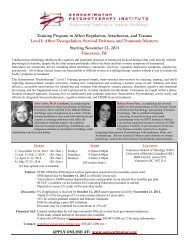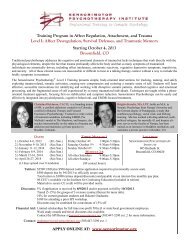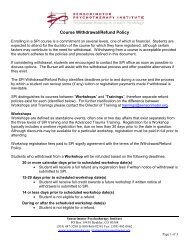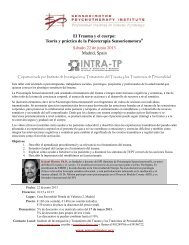Examining a Neglected Perspective - Sensorimotor Psychotherapy ...
Examining a Neglected Perspective - Sensorimotor Psychotherapy ...
Examining a Neglected Perspective - Sensorimotor Psychotherapy ...
Create successful ePaper yourself
Turn your PDF publications into a flip-book with our unique Google optimized e-Paper software.
PsycCRITIQUES - Trauma and the Body: <strong>Examining</strong> a <strong>Neglected</strong> <strong>Perspective</strong><br />
http://psycnet.apa.org/index.cfm?fa=main.showContent&id=2007-04533-001&view=fulltext<br />
Page 1 of 8<br />
8/9/2007<br />
Trauma and the Body: <strong>Examining</strong> a <strong>Neglected</strong><br />
<strong>Perspective</strong><br />
A review of<br />
Trauma and the Body: A <strong>Sensorimotor</strong> Approach<br />
to <strong>Psychotherapy</strong><br />
by Pat Ogden, Kekuni Minton, and Clare Pain<br />
New York: Norton, 2006. 345 pp. ISBN 978-0-393-<br />
70457-0. $35.00<br />
Reviewed by<br />
Sandra S. Lee<br />
Trauma and the Body: A <strong>Sensorimotor</strong> Approach to <strong>Psychotherapy</strong><br />
is written by Pat Ogden, Kekuni Minton, and Clare Pain. Forewords<br />
are provided by Daniel Siegel and Bessel Van der Kolk. This book<br />
is part of the Norton Series on Interpersonal Neurobiology, which<br />
seeks to understand how the structure and function of the mind<br />
and brain are shaped by experiences, especially emotional and<br />
interpersonal experiences. Scientific findings from different<br />
interdisciplinary areas converge to bring us new information about
PsycCRITIQUES - Trauma and the Body: <strong>Examining</strong> a <strong>Neglected</strong> <strong>Perspective</strong><br />
http://psycnet.apa.org/index.cfm?fa=main.showContent&id=2007-04533-001&view=fulltext<br />
Page 2 of 8<br />
8/9/2007<br />
mental health and well-being. This is the promise of the series and<br />
the book.<br />
The central idea of interpersonal neurobiology is that<br />
integration is central to well-being. In therapy, we attempt to<br />
integrate sensations, images, feelings, and thoughts that<br />
constitute ongoing experience. Trauma and the Body focuses on<br />
sensorimotor experiences, using the wisdom of the body to<br />
integrate these sensations, images, feelings, and thoughts. We<br />
know that trauma itself is so often body based, and more<br />
traditional verbal and cognitive approaches to therapy are not<br />
always as effective, or as rapid, as they might be (Shapiro, 2001).<br />
What this book can bring to the majority of more traditional<br />
therapists is the theoretical and research base for, and emphasis<br />
on, body-based techniques and understandings.<br />
The sensorimotor approach is so much more than just using<br />
the body as another frame of reference for the work of therapy.<br />
This approach has been described as using the sensations,<br />
impulses, and movements of the body to enable the therapist to<br />
open up the client's nonverbal world and make it available for<br />
integration and processing by the client.<br />
This is an exceptional book. The first half of the book<br />
develops a scientific and theoretical framework, integrating current<br />
and past empirical research from several areas. The authors posit<br />
that clinicians should understand the nonverbal neural and<br />
interpersonal processing of the individual. The second half of the<br />
book provides clinical interventions and case examples of use to<br />
any therapist who treats trauma, from almost any theoretical point<br />
of view. A phase-oriented approach to using sensorimotor<br />
interventions is developed and expanded.<br />
The authors emphasize that the therapist can and should be<br />
in touch with the communications of the client's body throughout<br />
the session. These communications may include how the client is<br />
standing, sitting, walking, talking, or gesturing. They also include<br />
bodily organization that reflects perhaps more directly the<br />
traumatic material, such as, for example, hyperarousal, trembling,
PsycCRITIQUES - Trauma and the Body: <strong>Examining</strong> a <strong>Neglected</strong> <strong>Perspective</strong><br />
http://psycnet.apa.org/index.cfm?fa=main.showContent&id=2007-04533-001&view=fulltext<br />
Page 3 of 8<br />
8/9/2007<br />
a collapsed chest or rounded shoulders, constriction, and holding<br />
of the breath. The therapist unobtrusively notices and tracks these<br />
communications, hypothesizing and learning what they<br />
communicate, then reflecting back these observations or designing<br />
interventions to address them.<br />
For example, the belief that “I have to be a high achiever to<br />
be loved” may be associated with overall tension, quick and<br />
focused movements, and an erect and rigid posture. These may be<br />
seen as physical tendencies that reflect “working hard” (p. 190).<br />
The communications of the body are used in the session just as<br />
verbal and other communications may be used.<br />
Body communications may be pointed out, questioned,<br />
commented on, or discussed, or the therapist may choose to<br />
correct or work with bodily communications in a more direct way.<br />
This might involve, for example, changing posture, focusing on<br />
and practicing straightening the spine, then being aware of the<br />
feeling of competence that may be associated with this for an<br />
individual client. This brings us to another important point and<br />
focus of this book: The therapist does not attend just to bodily<br />
organization that reflects trauma but also to bodily organization<br />
that reflects competence and well-being. This may include deep<br />
and regular breathing, relaxation, flexibility, physical alignment,<br />
and so on.<br />
The therapist pays attention to all levels of information being<br />
presented by the client, including emotional and cognitive aspects,<br />
and how the narrative affects the client's bodily experience. The<br />
therapist describes changes and communications observed in the<br />
client's body as they unfold in the moment. These statements<br />
direct the client's attention to present bodily experience. In the<br />
same way, statements about the client's emotional content or<br />
cognitive content direct attention to the emotional or cognitive<br />
aspects of the experience.<br />
This book is well written, and it is well organized for the<br />
reader. As an example, Chapter 9, titled “The Organization of<br />
Experience: Skills for Working With the Body in Present Time,”
PsycCRITIQUES - Trauma and the Body: <strong>Examining</strong> a <strong>Neglected</strong> <strong>Perspective</strong><br />
http://psycnet.apa.org/index.cfm?fa=main.showContent&id=2007-04533-001&view=fulltext<br />
Page 4 of 8<br />
8/9/2007<br />
begins with a brief summary of how the practice of sensorimotor<br />
psychotherapy blends interventions and techniques from<br />
psychodynamic and cognitive approaches. Working with<br />
somatically based interventions may involve, for example, working<br />
with movement or gesture and/or learning to track bodily<br />
sensations, movements, and changes. There is a subsection on<br />
“Tracking and Bodyreading” that describes this foundational skill,<br />
supplemented with case examples.<br />
The next subsection deals with “Contact Statements,” which<br />
addresses communicating relevant observations about bodily<br />
changes, gestures, or movements. Again, implications and<br />
examples are discussed and are integrated with quotations from<br />
other writers in related areas. The next subsection, “Mindfulness,”<br />
explains how tracking and contact statements can facilitate<br />
mindfulness for the client. Mindfulness, according to the authors,<br />
can help the client access underlying traumatic “tendencies and<br />
resources” (p. 195).<br />
The next subsection, “Experiments and Exploration,”<br />
provides examples of ways the therapist can encourage<br />
exploration of, and new responses to, postures, gestures,<br />
movements, and physical tendencies that reflect the traumatic<br />
experience carried in the present. Four specific ways of<br />
experimenting are provided for the therapist–reader. The next<br />
section, “Putting Skills Together,” discusses integrating resources<br />
and deciding which element of present-moment experience should<br />
be emphasized.<br />
The final three chapters parallel Judith Herman's (1992)<br />
phase-oriented approach to the treatment of traumatic stress. For<br />
Herman, Phase 1 treatment involves establishing a sense of safety<br />
and security through self-care. The establishment of safety and<br />
security, for Herman, begins with the body. Ogden et al.'s chapter<br />
focuses on somatic resources, as well as physical actions that can<br />
be taught to clients. These somatic resources support the goal of<br />
stabilization, and initially this is done without addressing the<br />
memory of the traumatic events.
PsycCRITIQUES - Trauma and the Body: <strong>Examining</strong> a <strong>Neglected</strong> <strong>Perspective</strong><br />
http://psycnet.apa.org/index.cfm?fa=main.showContent&id=2007-04533-001&view=fulltext<br />
Page 5 of 8<br />
8/9/2007<br />
The therapist assesses both existing somatic resources and<br />
those that may be lacking for the individual client, through<br />
bodyreading, tracking, discussion, and history taking. Throughout<br />
this phase, careful attention is given to timing and pacing, to<br />
boundary maintenance, and to a mindful and gradual reconnection<br />
with the body. The chapter provides extensive information,<br />
techniques, and case examples for the therapist to work with<br />
hypo- and hyperarousal, body sensations, self-soothing, and<br />
numerous other somatic issues. Breathing, eye contact, and a<br />
variety of sensation and body movement issues, reflecting<br />
boundary and psychological issues, are discussed fully.<br />
Phase 2 of treatment in sensorimotor psychotherapy involves<br />
“processing traumatic memory and restoring acts of triumph” (p.<br />
234). The authors believe that successful integration of dissociated<br />
and nonverbal memory fragments is optimized when clients work<br />
somatically. Clients can learn to feel empowered in relation to the<br />
traumatic memory and begin to move on. The goal here is to<br />
reintegrate all aspects of the traumatic memory, including<br />
dissociate aspects.<br />
Integrating current research and drawing on the work of<br />
Bessel van der Kolk and many others, the authors bring body<br />
memory and nonverbal memory into awareness, while at the same<br />
time maintaining an optimal level of arousal for the client. The<br />
“acts of triumph” in the chapter title refer to the completion of<br />
failed defensive actions that occurred at the time of the trauma.<br />
The focus here is on completing the physical actions. The<br />
traumatic memory then becomes associated with empowering<br />
actions and their corresponding emotions and cognitions (p. 248).<br />
The chapter on Phase 3 of treatment is titled “Integration<br />
and Success in Normal Life.” In this phase the focus is on<br />
expanding social support and connections, overcoming fears of<br />
daily life, and developing occupational needs and goals. The<br />
therapist here discovers and changes both cognitive distortions<br />
and physical tendencies that may hinder or prevent the<br />
development of these areas. The therapist works with both core
PsycCRITIQUES - Trauma and the Body: <strong>Examining</strong> a <strong>Neglected</strong> <strong>Perspective</strong><br />
http://psycnet.apa.org/index.cfm?fa=main.showContent&id=2007-04533-001&view=fulltext<br />
Page 6 of 8<br />
8/9/2007<br />
and periphery parts of the body, which may be overly tense,<br />
sluggish, or disconnected. For example, without a strong and<br />
stable core, the spine may be weak or may sag. This affects the<br />
client's posture, and the physical appearance may be stooped<br />
over, slumped, “not being able to hold yourself up” (p. 273). This<br />
may correspond with a client's feelings of being helpless,<br />
dependent, not competent, or needy. Physical experiments with<br />
the arms, such as asking the client to reach out, may be used to<br />
help assess relational disturbances.<br />
In some ways the book can be seen as the next giant step<br />
after Van der Kolk, MacFarlane, and Weisaeth's (1996) Traumatic<br />
Stress: The Effects of Overwhelming Stress on Mind, Body, and<br />
Society. Van der Kolk's work is liberally used and cited. Another<br />
important thinker in the treatment of trauma, Judith Herman<br />
(1992), is cited, but I would have liked to see more exploration of<br />
the parallels with Herman's work. Eugene Gendlin's (1981) work<br />
on focusing is also cited, but again I would have liked to see more<br />
discussion of the impact and intersection of Gendlin's work with<br />
sensorimotor psychotherapy.<br />
In addition, as I read the book, I found overlap with the<br />
techniques of eye movement desensitization and reprocessing<br />
(EMDR; Shapiro, 2001), yet there is no mention at all of EMDR,<br />
with its focus on physical sensations and imagery. Imagery, of<br />
course, involves powerful and often vivid sensations—seeing,<br />
hearing, touching, smelling, feeling. In EMDR, the image of the<br />
traumatic memory often changes to incorporate failed defensive<br />
actions and other more positive associations. The imagery itself in<br />
EMDR can involve imagined physical movements. It seems that<br />
there is an important bridge here that can be explored.<br />
Another area that can be explored further is that of<br />
indications and contraindications (if any) of sensorimotor<br />
psychotherapy. It may be quite valuable with clients who are less<br />
verbal (or too verbal). It may also have as yet unexplored<br />
applications for athletes. I present these thoughts more in the<br />
nature of personal observations rather than scholarly criticism of
PsycCRITIQUES - Trauma and the Body: <strong>Examining</strong> a <strong>Neglected</strong> <strong>Perspective</strong><br />
http://psycnet.apa.org/index.cfm?fa=main.showContent&id=2007-04533-001&view=fulltext<br />
Page 7 of 8<br />
8/9/2007<br />
the book.<br />
The integration of theory, research, and practice is a model<br />
rarely achieved, especially in such a readable and interesting book.<br />
This book will be read and valued by researchers and clinicians<br />
alike, as well as academics and those who already practice bodyoriented<br />
psychotherapies. This is a rare achievement.<br />
I hope this attempt to create a concise and informative<br />
review has not oversimplified what is a highly complex,<br />
multilayered, research-based, clinically oriented book. At the same<br />
time, it is highly organized, simply written, and accessible to<br />
therapists of any persuasion who would like to incorporate<br />
sensorimotor techniques and understandings into their work. This<br />
book is highly recommended.<br />
References<br />
Gendlin, E. (1981). Focusing. New York: Bantam Books.<br />
Herman, J. (1992). Trauma and recovery. New York: Basic Books.<br />
Shapiro, F. (2001). Eye movement desensitization and<br />
reprocessing: Basic principles, protocols, and procedures<br />
(2nd ed.). New York: Guilford Press.<br />
Van der Kolk, B. A., MacFarlane, A. C., & Weisaeth, L. (Eds.).<br />
(1996). Traumatic stress: The effects of overwhelming<br />
experience on mind, body, and society. New York: Guilford<br />
Press.<br />
PsycCRITIQUES<br />
August 8, 2007, Vol. 52, Release 32,
PsycCRITIQUES - Trauma and the Body: <strong>Examining</strong> a <strong>Neglected</strong> <strong>Perspective</strong><br />
http://psycnet.apa.org/index.cfm?fa=main.showContent&id=2007-04533-001&view=fulltext<br />
Page 8 of 8<br />
8/9/2007<br />
1554-0138<br />
Article 7<br />
© 2007, American Psychological Association










